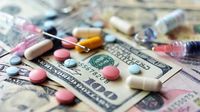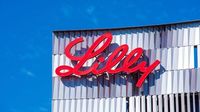Eli Lilly shares surged on Thursday, April 17, 2025, rising as much as 12 percent after the release of positive data from a Phase 3 clinical trial for its oral diabetes medication, Orforglipron. This significant jump positioned Eli Lilly among the top gainers on Wall Street, reflecting investor enthusiasm over the drug's promising results.
The Phase 3 ACHIEVE-1 study demonstrated that Orforglipron achieved its primary endpoint, showing a substantial improvement in blood sugar levels, specifically the HbA1c metric, in adults diagnosed with type 2 diabetes. According to Eli Lilly, Orforglipron is the first oral GLP-1 receptor agonist in tablet form to successfully complete a Phase 3 study, marking a notable milestone in diabetes treatment.
Results from the study indicated an average HbA1c reduction ranging from 1.3 to 1.6 percentage points from a baseline of 8.0 percent. Impressively, over 65 percent of participants who received the highest dose of Orforglipron achieved an HbA1c value of 6.5 percent or lower, which aligns with the target set by the American Diabetes Association. Furthermore, patients taking the highest dose experienced an average weight loss of 7.9 percent, roughly equivalent to 16 pounds.
Eli Lilly's CEO, David Ricks, highlighted the advantages of Orforglipron as an oral therapy, emphasizing its ease of use as a tablet that does not require dietary restrictions. “As a practical, once-daily tablet, Orforglipron could represent a new option and, if approved, could be manufactured and marketed on a large scale, benefiting people worldwide,” Ricks stated.
The ACHIEVE-1 study is the first of seven Phase 3 trials that Eli Lilly plans to conduct to evaluate the safety and efficacy of Orforglipron for both diabetes and obesity. Analysts view this drug as a potentially significant addition to the expanding market for GLP-1 therapies, which have gained traction due to their effectiveness in managing blood sugar and aiding weight loss.
On the same day, Eli Lilly's stock saw a pre-market increase of nearly 15 percent, driven by the positive reception of the study results. The experimental drug's efficacy in promoting weight loss of almost 8 percent at the highest dosage and lowering blood sugar levels among overweight patients with type 2 diabetes were particularly well-received by investors.
The stock price of Eli Lilly, trading at approximately $734.90 on the NYSE, reflects the optimism surrounding its new diabetes treatment. In contrast, shares of its competitor, Novo Nordisk, fell by over 4 percent following the announcement of Eli Lilly's promising data. The investment bank Exane BNP had even placed Novo Nordisk on its sales list, indicating a bearish outlook amidst Eli Lilly's breakthrough.
While Novo Nordisk is also developing weight loss medications, analysts caution against hasty reactions to Eli Lilly's success. Both companies are vying for a share of a lucrative market that is expected to grow significantly as more patients seek effective treatments for obesity and diabetes.
In addition to Orforglipron's promising results, Eli Lilly reported that it expects to submit applications for the drug's approval for use in obesity and overweight patients by the end of 2025, with a separate application for type 2 diabetes planned for 2026. If approved, Orforglipron could offer a practical alternative to existing injectable therapies, potentially transforming treatment options for millions.
The excitement surrounding Orforglipron is not just about its efficacy; it also represents a shift in how diabetes medications are administered. Traditionally, GLP-1 therapies have been available only as injections, which can be a barrier for many patients. The oral formulation of Orforglipron could encourage wider adoption, helping those who prefer pills over needles.
Ricks expressed satisfaction with the study results, stating, “We are very pleased with the outcomes. This new pill could help people globally without the restrictions that come with injections.” The most common side effects reported during the trial were gastrointestinal issues, such as nausea and diarrhea, which were generally mild to moderate and led to few participants discontinuing treatment.
As Eli Lilly continues to advance its research and development efforts, the potential for Orforglipron to reshape the diabetes treatment landscape is becoming increasingly clear. The company is well-positioned to capitalize on the growing demand for effective diabetes and obesity medications, and its stock performance reflects investor confidence in this trajectory.
In light of the recent developments, analysts estimate that Eli Lilly shares could see a further increase of up to 37 percent, suggesting that the company remains a strong contender in the pharmaceutical market. With the combination of innovative products like Orforglipron and a solid market strategy, Eli Lilly is poised for sustained growth, even as competition intensifies.
Overall, the success of the ACHIEVE-1 study and the anticipated market entry of Orforglipron could mark a significant turning point not only for Eli Lilly but also for the broader landscape of diabetes and obesity treatment. As the company navigates the regulatory process and prepares for potential commercialization, stakeholders will be closely monitoring the developments in this promising area of medicine.







